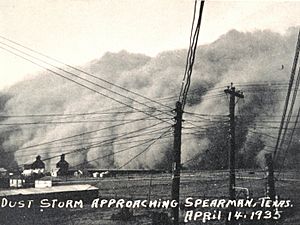Soil erosion facts for kids
Soil erosion happens when the top layer of soil (dirt) is washed away by water or blown away by wind. This is a big problem for farmers. When soil erodes, crops do not grow well.
A famous example of soil erosion was the Dust Bowl in the Midwestern United States. This happened in the 1930s.
Erosion can also create large holes in the ground called sinkholes. These holes can make buildings weak. Sometimes, buildings can even fall down because of them. Cities usually have ways to protect against soil erosion. This means buildings in cities are safer.
Contents
How to Protect Soil from Erosion
We can protect soil from eroding in several ways. These methods help keep the valuable topsoil in place.
Using Windbreaks
A windbreak is a line of plants. These plants are grown to stop or slow down the wind. A thick row of bushes or shrubs can be planted next to a field. This helps stop the wind from blowing the soil away. Windbreaks also help with water erosion. The soil gets caught by the roots of the bushes. This stops it from washing away.
Building Terraces
Terraces are flat areas made on hillsides. They look like giant steps. Farmers use them for a method called Terrace farming. This helps slow down water as it moves down the hill. It stops the soil from being washed away.
Planting Along Contour Lines
If crops are growing on a slope, farmers should plant them in contour lines. These lines run across the slope, not up and down. For example, if a hill goes down to the south, plants should be in rows from east to west. This method helps to slow water runoff. It keeps the soil from eroding.
Protecting Coastlines
Special structures can protect beaches and cliffs. Groynes are wooden walls built along beaches. They help stop erosion from the ocean. Sea walls are strong barriers built against cliffs. They protect the land from strong waves.
Images for kids
-
An actively eroding rill on an intensively-farmed field in Germany
-
Soil and water being splashed by the impact of a single raindrop.
-
A spoil tip covered in rills and gullies due to erosion processes caused by rainfall: Rummu, Estonia
-
Dobbingstone Burn, Scotland—This photo illustrates two different types of erosion affecting the same place. Valley erosion is occurring due to the flow of the stream, and the boulders and stones (and much of the soil) that are lying on the edges are glacial till that was left behind as ice age glaciers flowed over the terrain.
-
During the 17th and 18th centuries, Easter Island experienced severe erosion due to deforestation and unsustainable agricultural practices. The resulting loss of topsoil ultimately led to ecological collapse, causing mass starvation and the complete disintegration of the Easter Island civilization.
-
Terracing is an ancient technique that can significantly slow the rate of water erosion on cultivated slopes.
-
A windbreak (the row of trees) planted next to an agricultural field, acting as a shield against strong winds. This reduces the effects of wind erosion, and provides many other benefits.
See also
 In Spanish: Erosión en el suelo para niños
In Spanish: Erosión en el suelo para niños















